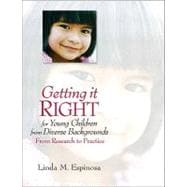
Note: Supplemental materials are not guaranteed with Rental or Used book purchases.
Purchase Benefits
What is included with this book?
Dr. Linda M. Espinosa, recently retired Professor of Early Childhood Education at the University of Missouri, Columbia, served as the Co-director of the National Institute for Early Education research at Rutgers University from 2002 to 2003. Her recent research and policy work has focused on effective curriculum and assessment practices for young children from low-income families who are dual language learners. She has served as a consulting editor for Early Childhood Research Quarterly, Early Childhood Research & Practice, Information Technology in Childhood Education, and Prevention Researcher, and serves on multiple national commissions and advisory boards. She currently serves as the Co-Chair of the First Five, Los Angeles Universal Preschool research Advisory committee and is a member of the National Task Force on Early Childhood Education for Hispanics Technical Advisory Group. Dr. Espinosa has worked extensively with low-income Hispanic/Latino children and families throughout the state of California as a school administrator and program director in San Francisco, San Jose, and Redwood City. She developed and directed the Family Focus for School Success program in Redwood City, California, which has received state and national recognition. She has published more then 50 research articles and training manuals on how to establish effective educational services for low-income, minority families and children who are acquiring English as a second language.
Why the Increased Focus on Early Childhood Programs Right Now?
Public Program for Young Children
Summary
Reflection and Discussion Questions
Chapter 2 The Changing Face of Early Childhood in the U.S.: New Promises
and Pitfalls
Current Demographics and Population Projections
Children in Poverty
Increasing Linguistic Diversity in Early Childhood Programs
Increases in Hispanic/Latino Population
Culture and Early Education
Preschool and English Language Learners
Early Education Standards Movement and Diversity
Summary
Reflection and Discussion Questions
Chapter 3 What Research Tells Us About The Needs and Abilities of All Young
Children
The Science of Early Education
Social-Emotional Roots of All Learning: The Importance of Positive Relationships
Implications of Research for Early Childhood Practitioners
Risk and Resiliency in Young Children
Summary
Reflection and Discussion Questions
Chapter 4 Research Findings and Recommendations for Children Living in
Poverty
Issues and Considerations for Children Living in Poverty
The Importance of Resiliency
What Teachers Can Do
School Readiness and Low-Income Children
The Importance of High Quality Curricula: Specific Strategies
Professional Development and Effective Teacher Supports
Achieving Success: Schools, Families, and Communities Working Together
Summary
Reflection and Discussion Questions
Chapter 5 Research on the Development, Learning and Teaching of Young English Language Learners
Issues and Considerations for ELL Children
Myths About English Language Learners Not Supported by Scientific Evidence
English Language Learners and School Readiness: Overlapping Influences of Language and Poverty
Role of Home Language in English Acquisition
How do Young Children Learn a Second Language?
Bilingualism and Social-Emotional Development
Research on Different Curriculum/Program Approaches
Working with ELL Families
Summary
Reflection and Discussion Questions
Chapter 6 Promising Curriculum and Assessment Strategies for Young
English Language Learners
The Importance of Goals
Specific Teaching Strategies in Dual Language Early Childhood Programs
The Importance of a Comprehensive Curriculum
Specific Strategies in English Language Programs with Home Language Support
Assessment Approaches: How to Collect Accurate Information on the Development of Dual Language Learners
Putting it All Together: ECE Settings Where ELL Children Can Flourish
Summary
Reflection and Discussion Questions
Chapter 7 Meeting the Future Challenges of Early Childhood Education
National Will/Consensus
Using Research, Advocacy, and Persistence to Move the Agenda Forward: Inch-by-Inch, Step-by-Step
Link to National Education Priorities/Policies
Investment/Resources Needed
Summary
Reflection and Discussion Questions
Appendix A
Sample Family Languages and Interests Survey
Appendix B
Resources for Serving Young Children from Diverse Backgrounds
Appendix C
Information on The Early Authors’ Program
Appendix D
Sample Individualized Language Plan
Glossary
References
Index
The New copy of this book will include any supplemental materials advertised. Please check the title of the book to determine if it should include any access cards, study guides, lab manuals, CDs, etc.
The Used, Rental and eBook copies of this book are not guaranteed to include any supplemental materials. Typically, only the book itself is included. This is true even if the title states it includes any access cards, study guides, lab manuals, CDs, etc.